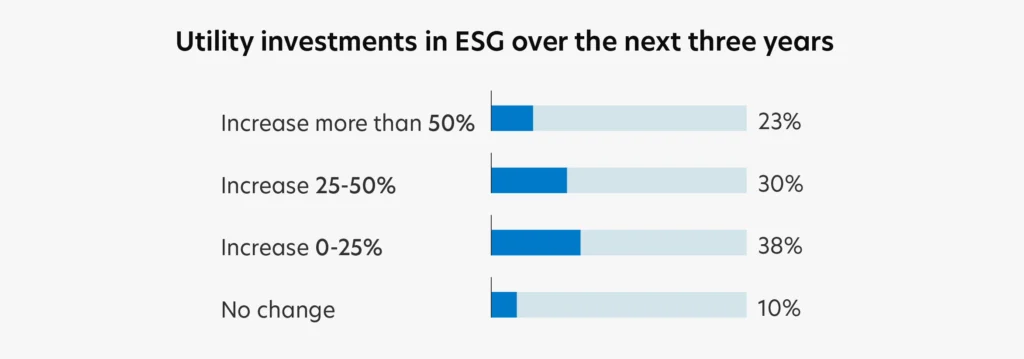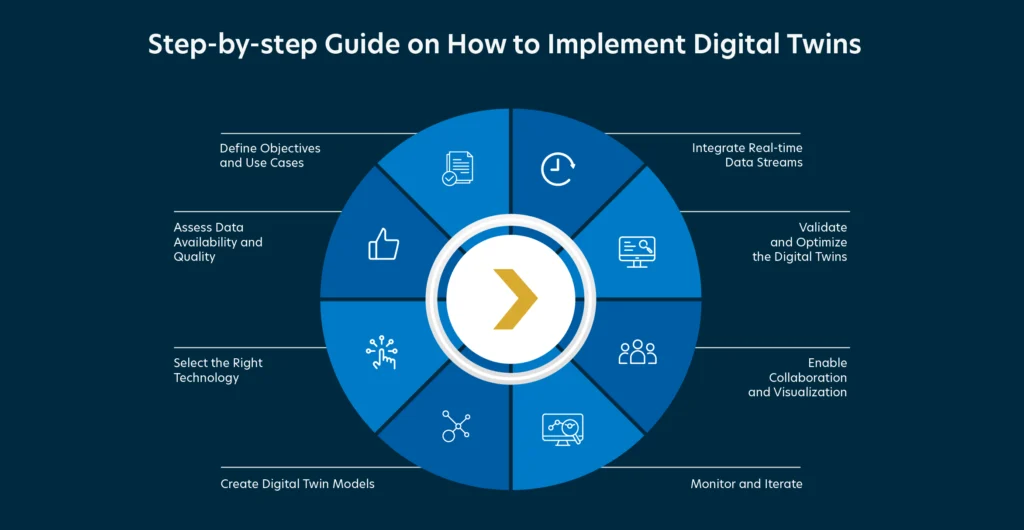Dear CTOs,
Did you know that as per McKinsey & Company reports, utility companies that harness the power of digital technologies can unlock up to a 25% reduction in operational costs and a 10-20% increase in asset uptime?
In an era where digital transformation has become a necessity, industries across the board are racing to adopt innovative technologies that can enhance operational efficiency and drive growth. The utility industry, in particular, is undergoing a significant shift as it embraces digital transformation to tackle challenges such as aging infrastructure, sustainability pressures, regulatory compliance, and the ever-mounting data deluge.
As the Chief Technology Officer (CTO) of a utility company, understanding the intricacies of this digital revolution and identifying the right tools to maximize return on investment (ROI) is paramount. One such technology that holds immense potential for the utility industry is digital twin technology.
Digital twins are not just digital replicas equipment, processes, information, and physical assets. But in practice, they manifest innovation and resilience, offering a mirror to reflect upon our systems and a crystal ball to envision the future. By utilizing digital twin technology to prioritize IT investments, utilities can ensure that they are investing in the most impactful projects with high returns on investment.
However, embarking on the path of digital transformation comes with its fair share of obstacles. From outdated infrastructure and sustainability concerns to navigating regulatory compliance, overwhelming influx of data and budget constraints, CTOs are often hesitant to make investments in emerging technologies.

Here are five ways how digital twin technology can be a catalyst to overcome these challenges and help CTOs invest in the right technology that drives operational efficiency and helps generate increased business ROI.
Challenge 1: Legacy Infrastructure and Systems
The utility sector often grapples with the burden of legacy IT infrastructure and systems that have existed for many years. These outdated systems are technologically obsolete and incompatible with modern technologies. Integrating new IT solutions with these legacy systems can be a daunting task.
Solution: According to a McKinsey report, integrating Digital Twins with legacy systems can yield up to 25% efficiency improvements, reducing operational costs significantly. By creating digital twins of critical infrastructure components, utilities can gain insights into the condition of aging assets. This proactive approach enables them to schedule maintenance when needed, reducing downtime and extending asset lifecycles.
Challenge 2: Sustainability Pressures
With the increasing emphasis on environmental sustainability and regulations to reduce greenhouse gas emissions, utilities face the challenge of aligning their IT investments with sustainability goals. Failure to meet these goals can result in regulatory penalties, damage to the company’s reputation, and higher operational costs.
Solution: Digital twins provide a platform for utilities to monitor and optimize their environmental impact. They can simulate different scenarios to identify opportunities for reducing carbon emissions and resource consumption, aligning their operations with sustainability goals.

Source: PWC, Power & Utilities ESG Survey, August 2021
Challenge 3: Regulatory Compliance
Utility companies are subject to stringent regulations to ensure essential services’ reliability, safety, and fair pricing. These regulations can pose a significant challenge when prioritizing IT investments. The need to navigate complex regulatory frameworks and ensure that new technologies comply with existing rules can divert resources, time, and attention away from IT projects. Meeting these compliance requirements is paramount, but it can also slow down the pace of technological adoption.
Solution: Digital twins serve as a centralized repository of data and insights, making it easier for utilities to comply with regulatory reporting requirements. They can provide regulators with accurate and up-to-date information, reducing the risk of compliance issues.
An executive working with energy and utilities business says, “In the power industry, we essentially need to submit our power-generation schedule, in terms of how much power we are going to provide to the grid, and at what frequency, and our [back-up] plan if we are unable to do so. Through the use of digital twins, we now have a more predictable generation schedule, with very minimal potential deviation or variance, thereby avoiding the stringent regulatory and financial penalties characteristic of our industry”
Challenge 4: Budget Constraints
Budget constraints are a universal challenge in the utility sector. Utilities often operate on tight budgets, with competing demands such as infrastructure maintenance, staffing, and service expansion. Allocating funds for IT investments, especially substantial ones like Digital Twin technology, can be daunting. As a result, there is a constant struggle to balance immediate operational needs with the long-term benefits of IT investments, potentially leading to underinvestment in crucial technologies.
Solution: Utilities should focus on Digital Twin projects with a clear and measurable impact on cost savings. These projects may involve optimizing asset management, predicting maintenance needs, or enhancing energy efficiency. The World Economic Forum reports that Digital Twins can lead to 10-20% cost reductions in asset management, making them a sound investment within budget constraints.
Challenge 5: Cybersecurity Concerns
Utilities are prime targets for cyberattacks due to the critical nature of their services. Safeguarding the integrity and security of their IT investments is of paramount importance. Implementing robust cybersecurity measures, including intrusion detection systems, encryption, and regular vulnerability assessments, is essential. However, these measures often come with a significant price tag and require ongoing investments in monitoring and updates, which can affect the pace of IT projects.
Research from Skybox Security found that 87% of utilities have experienced at least one security breach in the past 36 months.
One example worth highlighting is the malicious attack on a US-based utility that resulted in a loss of 90% of its internal systems and wiped out 25 years of historical data. Luckily, there was no impact on customer data or grid operations, but it was a relatively small utility company, which is a reminder that anyone is at risk.
Solution: Building Digital Twins with robust cybersecurity features is essential. Encryption, access controls, and intrusion detection systems can be integrated into the Digital Twin architecture to protect critical data and infrastructure. Regular security assessments and updates should be part of the maintenance plan.
Step-by-step Guide on How to Implement Digital Twins

Implementing digital twins in your organization can be a transformative process that unlocks numerous benefits. To help you navigate this journey, here is a step-by-step guide on how to implement digital twins effectively:
Step 1: Define Objectives and Use Cases
Start by defining clear objectives for implementing digital twins. Identify the specific areas or assets within your organization that can benefit from digital twin technology. Whether it’s optimizing operations, improving maintenance strategies, or enhancing decision-making, having a clear focus will guide your implementation process.
Step 2: Assess Data Availability and Quality
Evaluate the availability and quality of the data required to create digital twins. Ensure that you have access to accurate and reliable data about the physical assets or systems you want to replicate digitally. Identify any gaps in data collection and establish processes to gather missing information.
Step 3: Select the Right Technology
Choose the appropriate digital twin technology that aligns with your objectives and requirements. Consider factors such as scalability, compatibility with existing systems, analytics capabilities, and user-friendliness. Collaborate with technology vendors or consultants who specialize in digital twin solutions to obtain expert guidance.
Step 4: Create Digital Twin Models
Develop digital twin models based on the selected technology and the data collected. This involves mapping the physical asset or system into a virtual representation. Use advanced modeling techniques, such as 3D visualization, simulation, and data integration, to ensure an accurate and dynamic digital twin.
Step 5: Integrate Real-time Data Streams
Integrate real-time data streams from the physical assets or systems into the digital twin models. This may involve setting up sensors, IoT devices, or data connectivity solutions to capture and transmit relevant data. Ensure that the data feeds are reliable, secure, and synchronized with the digital twin models.
Step 6: Validate and Optimize the Digital Twins
Validate the accuracy and performance of the digital twins by comparing their behavior with the corresponding physical assets or systems. Continuously monitor and refine the digital twin models to improve their accuracy and predictive capabilities. Leverage advanced analytics and machine learning algorithms to detect anomalies, predict failures, and optimize performance.
Step 7: Enable Collaboration and Visualization
Provide access to the digital twin models and insights to relevant stakeholders within your organization. Enable collaboration between different teams, such as operations, maintenance, and engineering, to leverage the benefits of digital twins collectively. Implement visualization tools and dashboards to facilitate data interpretation and decision-making.
Step 8: Monitor and Iterate
Establish a robust monitoring system to track the performance and effectiveness of the implemented digital twins. Regularly review the outcomes and iterate on the models and processes to drive continuous improvement. Stay updated with technological advancements and industry best practices to enhance the value derived from digital twin implementations.
Wrap up:

Traditional strategies for IT investment prioritization cannot keep pace with today’s fast-changing utility landscape, which is why innovative solutions such as digital twin technology are necessary for sustained success in this sector.
While it can be challenging to adopt new technologies or methods of operation, businesses must recognize that inaction or continued use of outdated techniques could cost them significantly in the long run. Incorporating digital twin technology may present short-term challenges but ultimately offers a better return on investment over time.
Are you a utility company looking to make the most of your IT investments? Well, look no further!
At Quinnox, we understand the transformative power of Digital Twin technology. We bring a unique angle to this transformation, offering innovative approaches to implementing and optimizing digital twins, ensuring that your IT investments lead to maximum ROI. So, as you embark on your journey to prioritize IT investments in the utility industry, remember that Digital Twin Technology isn’t just a tool; it’s a strategic enabler of growth, efficiency, and sustainability.
Connect with our Experts Today!